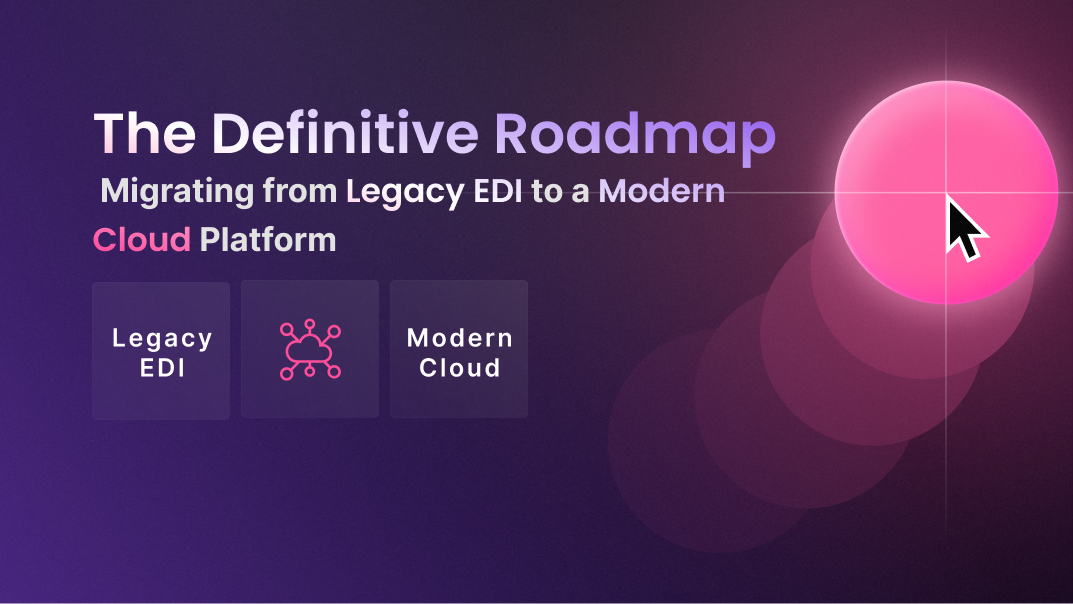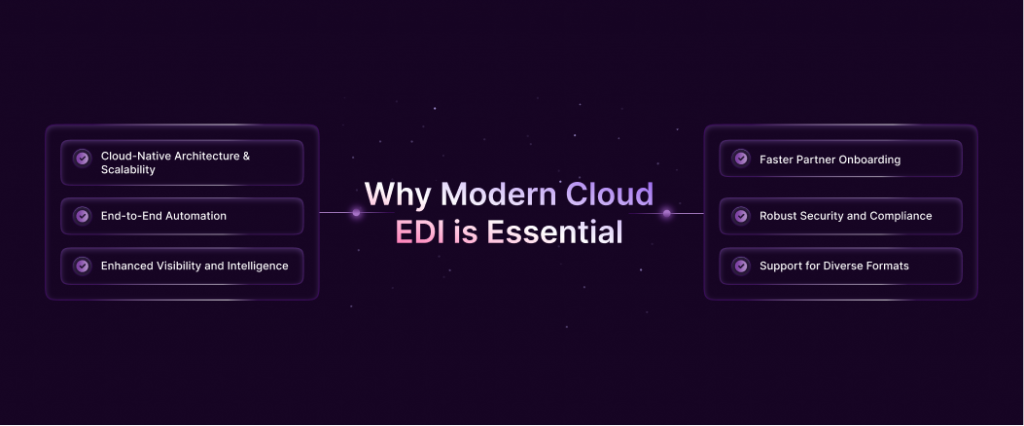The Definitive Roadmap: Migrating from Legacy EDI to a Modern Cloud Platform

Many businesses today are still relying on legacy, on-premises EDI systems that slow down operations, increase costs, and limit visibility. For example, one fast-growing manufacturer found that every compliance update required costly custom coding, while their ERP integration constantly broke down. By moving to a modern, cloud-based EDI platform, the company was able to run a pilot to automate key partner transactions, reducing manual work by 60% and cutting integration costs by nearly half. The result was faster partner onboarding, real-time ERP synchronization, and improved operational efficiency.
This guide provides a step-by-step roadmap for Legacy EDI Migration, helping businesses transition from outdated systems to modern, automated, and compliant cloud EDI solutions that scale effortlessly with growth.
Why Legacy Systems Are Holding You Back
Legacy EDI systems struggle with modern business demands due to several critical limitations:
1. Lack of Agility and Flexibility: These systems are rigid, use proprietary point-to-point connections, and require costly, specialized IT expertise. Making a simple change (like adding a new partner) can take weeks or months, halting business growth.
2. High Costs and IT Burden: Prohibitive initial and ongoing maintenance costs are driven by expensive, specialized hardware, on-premise infrastructure, and the need for rare skills (e.g., COBOL programmers).
3. Lack of Real-Time Visibility: They rely on batch processing, creating delays and a critical lack of real-time insight into orders, shipments, and inventory, making quick, informed decision-making impossible.
4. Security and Compliance Risks: Older systems often lack modern security protocols and struggle to keep up with rapidly evolving global regulatory requirements (like GDPR or e-invoicing mandates), leaving businesses vulnerable.
5. Integration and Data Silos: They are difficult to integrate with modern applications (ERP, CRM, cloud services), leading to data silos and forcing manual, error-prone data re-entry across systems.
6. Scalability Constraints: Legacy architecture wasn’t built for today’s massive transaction volumes. Scaling up is difficult and expensive, creating performance bottlenecks during seasonal peaks or rapid growth.
Why Modern Cloud EDI Is Essential

Modern EDI solutions (cloud-based and API-enabled) transform B2B communication from a rigid utility into a strategic business accelerator. They directly address every legacy shortcoming:
1. Cloud-Native Architecture & Scalability: Provides unprecedented flexibility, resilience, and elasticity. It enables real-time data exchange instead of batch processing and eliminates the need for expensive on-premise hardware, dramatically lowering IT overhead. EDI-as-API platforms like Zenbridge have handled over 100 + Million transactions, proving it can scale effortlessly.
2. End-to-End Automation: Automates the entire transaction lifecycle, from order receipt to invoicing. This eliminates manual data entry, drastically reducing human error (and costly chargebacks) and freeing up teams for strategic work. Case studies show that automation on modern platforms saves teams over 550+ hours of manual efforts annually.
3. Enhanced Visibility and Intelligence: Offers user-friendly dashboards and real-time monitoring of all transaction flows. This enables proactive error resolution and provides valuable business intelligence for supply chain optimization.
4. Faster Partner Onboarding: Modern platforms leverage reusable mapping libraries and centralized configuration to onboard new partners efficiently, often in days or weeks, directly supporting rapid market expansion. Platforms like Zenbridge can complete the full EDI integration (including testing) in as little as 2 to 3 weeks, compared to 3-9 months for legacy systems.
5. Robust Security and Compliance: Includes advanced security measures (like end-to-end encryption and audit trails) and is constantly updated to meet the latest global and industry-specific regulations automatically.
6. Support for Diverse Formats: Seamlessly handles traditional standards (X12, EDIFACT) alongside modern formats like XML, JSON, and APIs, ensuring compatibility with all partners regardless of their technological maturity.
The Migration Roadmap: Legacy to Modern
A successful migration requires a structured, phased approach to manage complexity and minimize disruption.
Phase A: Assessment and Discovery
The goal is to establish a clear baseline and define measurable objectives for the new system.
1. System Inventory & Audit: Document all current hardware, software, and database versions. Critically, document all customizations (proprietary data formats, custom code) and integration points with internal applications (ERP, WMS).
2. Performance and Pain Point Analysis: Quantify current performance by measuring transaction processing speeds, error rates, and downtime. Gather qualitative feedback from users on key pain points like costly maintenance and lack of visibility to justify the migration goals.
3. Trading Partner & Document Review: Compile a comprehensive list of all active trading partners, the specific EDI document types exchanged (e.g., 850, 810), and their required protocols (AS2, SFTP). Review all existing data maps to accurately estimate re-mapping effort for the new system.
Phase B: Platform Selection
Choose a modern EDI platform that acts as a strategic partner, not just a service provider.
1. Deployment & Scalability: Prioritize a cloud-native architecture that delivers automatic, elastic scaling for peak seasons without manual hardware upgrades or disruptive licensing changes. However, a hybrid model can serve as a practical interim step allowing businesses to retain certain systems or data on-premise until a full migration to the cloud is complete, especially useful when maintaining compliance with data residency regulations or managing highly customized legacy integrations during the transition.
2. Integration Capabilities: Look for platforms that offer real-time API integration and pre-built connectors for core applications (SAP, Oracle, NetSuite) to eliminate manual data entry and ensure reliable synchronization.
3. Standards & Compliance: The platform must support all major standards (X12, EDIFACT, JSON, XML) and deliver automatic compliance updates to manage evolving mandates like e-invoicing.
4. Visibility & Monitoring: Demand real-time dashboards that track every stage of documents (orders, invoices) and include proactive alerts to flag errors quickly before they disrupt the supply chain.
5. Support & Expertise: Choose a vendor with proven experience in legacy-to-modern transitions that offers dedicated support throughout the critical migration and post-go-live phases.
Phase C: Developing the Migration Plan (Go-Live Roadmap)
Break the transition into manageable steps with a focus on mitigating risk.
1. Data Preparation and Mapping: This is the most critical step. Meticulously convert legacy formats and custom code into the new system’s standardized formats. Validate all data migration using volume checks and reconciliation reports to ensure no loss or corruption of essential business data. During this phase, a hybrid setup where certain processes remain on-premise while others run in the new platform can help maintain operational continuity until full cloud migration is complete. Zenbridge EDI-as-API offers an unmatchable pricing model, with transaction fees as low as $0.05/transaction, providing immediate cost savings over traditional VANs and complex legacy licenses.
2. Testing and Validation: Set up a dedicated sandbox environment to mirror production. First, validate internal processes (EDI platform ↔ ERP). Then, extend testing to trading partners—starting with high-volume or complex ones—to confirm end-to-end functionality.
3. Risk Mitigation: Plan for potential risks like data loss or cutover downtime. Maintain verified data backups, set up contingency communication channels with key partners, and whenever possible, plan for parallel runs where old and new systems operate side-by-side before decommissioning the legacy infrastructure. A hybrid deployment can also act as a safety net during this stage, ensuring critical operations remain uninterrupted.
Phase D: Training and Change Management
A successful migration depends on people adopting the new system with confidence.
1. Internal Training: Provide hands-on sessions tailored to different departments: IT staff on configuration, and operations/supply chain teams on workflows, dashboards, and error monitoring. Highlight how automation solves long-standing pain points.
2. Partner Communication: Notify partners early about the transition timeline. Share essential details, testing schedules, and new communication protocols (e.g., moving from VAN to AS2). Provide clear onboarding guides or self-service portals to ease their transition.
3. Change Management Strategy: Appoint “EDI champions” in key departments to advocate for the system and channel feedback. Focus the narrative on the long-term value: automation, error reduction, and real-time data flow.
Monitoring and Optimization (Post Go-Live)
Cutover is the start of continuous improvement.
Establish Key Performance Indicators (KPIs) such as order-to-cash cycle time and error rates to validate migration success against legacy benchmarks. Clarify support responsibilities between your internal team and the vendor (e.g., Zenbridge support). Cloud-native solutions simplify this by having the vendor automatically manage updates, patches, and compliance changes. Commit to continuous improvement by using feedback to uncover opportunities for greater automation and staying current with emerging standards and technologies.
Conclusion and Call-to-Action
The journey from a slow, costly, and risk-prone legacy EDI system to a modern, cloud-native platform is a fundamental supply chain transformation. By following this structured roadmap from rigorous assessment and strategic selection to meticulous testing and robust change management your business can replace technical debt with an agile, real-time B2B integration layer. A modern solution eliminates manual errors, drastically cuts operational costs, and provides the real-time visibility and speed essential for future-proofing your business.
Zenbridge is the modern, cloud-native platform designed to accelerate your migration with minimal disruption. We offer pre-built ERP connectors, rapid partner onboarding, and a dedicated team of experts to guide you through every step of the transition.
Book a Personalized Demo with Zenbridge Today See how easy it is to move your first trading partner and realize immediate cost savings.